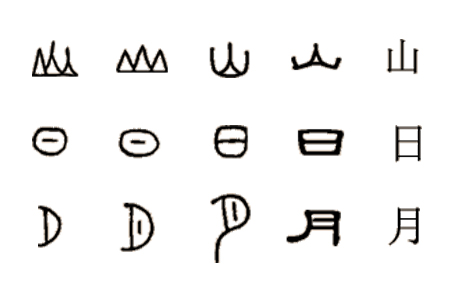The six principles of the Chinese writing
As you may already know Chinese language doesn’t have an alphabet and, even though quite often a word can consist of two or more characters, Chinese is per se a monosyllabic language in which each sign has its own meaning. Depending on their structure Chinese characters can be distinguished in what is known as “the six principles of Chinese language” or 六书 (liùshū):
- The pictograms or 象形 (xiàngxíng – literally “shape”), are characters that resemble the shape of the objects they represent and are the most ancient corpus of Chinese characters. Examples of pictograms are 日 (rì – “sun”), 月 (yuè – “moon”), 山 (shān – “mountain”)

- The simple indicatives or 指事 (zhǐ shì – literally “that indicates things”), are abstract illustrations of simple concepts. Examples of simple indicatives are 一 (yī – “one”), 上 (shàng – “up”), 中 (zhōng – “centre”)
- The associative compounds or 会意 (huìyì – literally “association of meaning”), are characters derived from the combination of simple characters resulting in a new meaning. An example of associate compound is 安 (ān – “peace”), consisting of 宀 (mián – “roof”) and 女 (nǚ – “woman”), hence a woman under a roof symbolizes peace
- The phono-semantic compounds or 形声 (xíngshēng – literally “shape-sound”), consist of an element indicating the sound and another indicating the meaning. Almost all Chinese characters belong to this group, where the semantic part consist of one of the so-called radicals. Radicals are the basic graphic elements according to which Chinese characters are cataloged and ranked in dictionaries. An example of phono-semantic compound is 妈 (mā – “mom”), consisting of 女 (nǚ – “woman”) and 马 (mǎ – “horse”). The first character is the radical and represents the semantic part, the second represents the phonetic part
- The phonetic loans or 假借 (jiǎjiè – literally “pseudo loan”), are homophonic words, that since they didn’t have a graphic equivalent in ancient times, they have been used to represent a new meaning, without any connection with those they were borrowed from. For example, in the past, the character 来 (lái) meant “wheat”. Since the verb “to come” was pronounced in the same way, but didn’t have a written equivalent yet and, most likely it would have been quite difficult to represent its concept, a decision was made to adopt the character 来 for the verb “to come” and to create a new one for “wheat”.
Cover background picture by Athena Lam
comments powered by Disqus